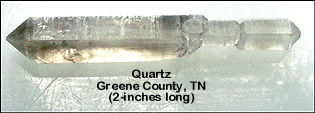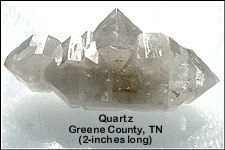According to Seneca, the Roman philosopher, statesman and dramatist who lived during the first century, "Luck is what happens when preparation meets opportunity." Our last field trip to northeastern Tennessee turned out to be a perfect example of his viewpoint.
By reading June Culp Zeitner's "Appalachian Mineral & Gem Trails" about ten years ago, I first became aware of the potential presence of quartz and geodes in the area of the "Mosheim Anticline" in Greene County, Tennessee. According to Zeitner, "Thin shelled quartz geodes and sometimes doubly terminated loose quartz crystals are found in the Midway-Mosheim disctrict associated with the Chepultepec limestone." As is common for me, I stored the information away in my brain thinking that someday I'd have to go investigate the area.
About a year ago, I had a conversation with a fellow rockhound who told me that he has collected what he referred to as "field diamonds" (quartz crystals) in the Mosheim area. Since I had just met this person, I didn't feel that it would be proper to ask him about a specific collecting location, but the information did rekindle my interest in checking out the area for myself.
A few months ago, I was looking for something new for me and Chrissy to prospect and, for whatever reason, I thought about the Mosheim area. So, in preparation, I ordered one of the references listed in Zeitner's book, "Geology and Mineral Deposits of the Mosheim and Johnson Anticlines, Greene County, Tennessee"; US Geological Survey Bulletin 1222-A; Arnold L. Brokaw, John C. Dunlap and John Rodgers; 1966. According to the authors, "Doubly terminated quartz crystals, averaging about 1 inch in length, and thin-walled geodes with drusy interior durfaces weather from the dolomite at the top of the Chepultepec [Dolomite]." In the publication were maps showing the Mosheim and Johnson Anticlines. I concentrated on the Mosheim since the general area appeared to be more accessible by road. However, I learned that the publication's map was badly dated so that its roads didn't match up exactly with a current road map. Also, since the anticline trends northeast to the southwest, the authors chose to depict the geologic map's north arrow at about 45-degrees right of vertical. While this may not seem like a big deal because all one would have to do is turn the geologic map to orient the north arrow up and down, having to do this compounded the difficulty of matching the older map's roads and features to those of the newer road map. It took me a few hours, but I managed to transpose the Chepultepec Dolomite map unit onto a current road map (a taped-together version from about 10 maps that I downloaded and printed from MapTech.com) so that we would be able to locate and follow the formation in the field.
Armed with the maps and information that I had compiled, we decided last Saturday to head out to the Mosheim area to put my geologizing to the test. The weather forecast for the day called for clear skies and a high in the mid-fifties - perfect for hunting sparkly quartz crystals. Prior experience in my combining geology and rockhounding has taught us that we maybe had a less than even chance of finding anything, but we were cautiously optimistic as we made the 100 mile drive.
Upon arriving in the area, we decided to start at the southwestern nose of the anticline and work our way to the northeast along roads that would allow us access to the erosional remains of the Chepultepec Dolomite. The anticline formed the elongate hill called "Big Ridge". According to the USGS publication, "The residual soil from the Chepultepec is orange and yellow and contains many manganese stains". Many different types of chert are found in the soil and make an abundant but not a heavy float." So, we knew to look for areas of disturbed soil with these characteristics.
We turned off the main highway onto a secondary road that appeared on the geologic map to be within the Chepultepec, but it was a dead end without any disturbed soil. Then, we headed down another secondary road. Do you remember the luck and preparation mumbo jumbo from that Roman dude that I quoted above - well, how do you say BINGO in Latin? We came upon a construction site in a field where the topsoil had been completely stripped away leaving behind orange soil littered with cherty looking rocks. Hmmm . . . could it be?
We put on our rubber boots and headed out into the muddy field. Within minutes, we started finding small quartz crystals - lots of them! Most were tiny, but some got up to around 2-inches long. The ground was also littered with countless chunks of mostly-gray chert. After only five minutes of looking, I was elated to pick up the following cool specimen.
 Click on picture to enlarge
Click on picture to enlarge
Not long after my little gem was found, an excited Chrissy came over and told me that I was going to pee myself if she showed me what she had found. I somehow managed to hold my bladder, but we were both thrilled with the stikingly ornate compound crystal.
 Click on picture to enlarge
Click on picture to enlarge
We spent the next several hours walking back and forth on the 3-acre plot of dirt and found more quartz crystals than we could have hoped for. The following pictures are a sampling of what we recovered from this one location.